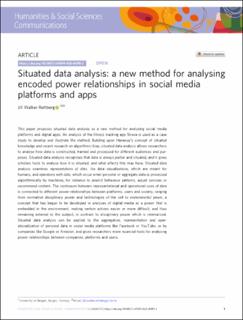| dc.contributor.author | Rettberg, Jill Walker | |
| dc.date.accessioned | 2021-03-12T10:14:45Z | |
| dc.date.available | 2021-03-12T10:14:45Z | |
| dc.date.created | 2020-05-23T14:42:45Z | |
| dc.date.issued | 2020 | |
| dc.identifier.issn | 2662-9992 | |
| dc.identifier.uri | https://hdl.handle.net/11250/2733099 | |
| dc.description.abstract | This paper proposes situated data analysis as a new method for analyzing social media platforms and digital apps. An analysis of the fitness tracking app Strava is used as a case study to develop and illustrate the method. Building upon Haraway’s concept of situated knowledge and recent research on algorithmic bias, situated data analysis allows researchers to analyse how data is constructed, framed and processed for different audiences and purposes. Situated data analysis recognizes that data is always partial and situated, and it gives scholars tools to analyse how it is situated, and what effects this may have. Situated data analysis examines representations of data, like data visualisations, which are meant for humans, and operations with data, which occur when personal or aggregate data is processed algorithmically by machines, for instance to predict behaviour patterns, adjust services or recommend content. The continuum between representational and operational uses of data is connected to different power relationships between platforms, users and society, ranging from normative disciplinary power and technologies of the self to environmental power, a concept that has begun to be developed in analyses of digital media as a power that is embedded in the environment, making certain actions easier or more difficult, and thus remaining external to the subject, in contrast to disciplinary power which is internalized. Situated data analysis can be applied to the aggregation, representation and operationalization of personal data in social media platforms like Facebook or YouTube, or by companies like Google or Amazon, and gives researchers more nuanced tools for analyzing power relationships between companies, platforms and users. | en_US |
| dc.language.iso | eng | en_US |
| dc.publisher | Springer Nature | en_US |
| dc.relation.uri | https://www.nature.com/articles/s41599-020-0495-3#citeas | |
| dc.rights | Navngivelse 4.0 Internasjonal | * |
| dc.rights.uri | http://creativecommons.org/licenses/by/4.0/deed.no | * |
| dc.title | Situated data analysis: a new method for analysing encoded power relationships in social media platforms and apps | en_US |
| dc.type | Journal article | en_US |
| dc.description.version | publishedVersion | en_US |
| dc.rights.holder | Copyright The Author(s) 2020 | en_US |
| dc.source.articlenumber | 5 | en_US |
| cristin.ispublished | true | |
| cristin.fulltext | original | |
| dc.identifier.doi | 10.1057/s41599-020-0495-3 | |
| dc.identifier.cristin | 1812236 | |
| dc.source.journal | Humanities & Social Sciences Communications | en_US |
| dc.source.40 | 7 | |
| dc.relation.project | EC/H2020/771800 | en_US |
| dc.relation.project | Norges forskningsråd: 259536 | en_US |
| dc.identifier.citation | Humanities and Social Sciences Communications. 2020, 7, 5. | en_US |
| dc.source.volume | 7 | en_US |

